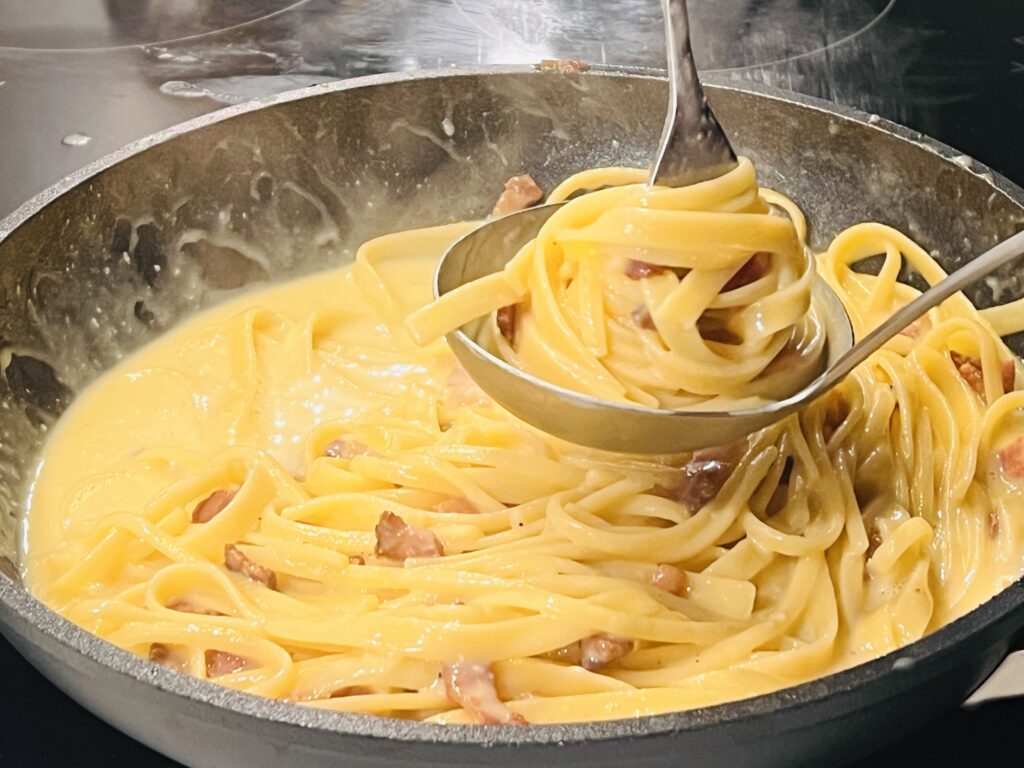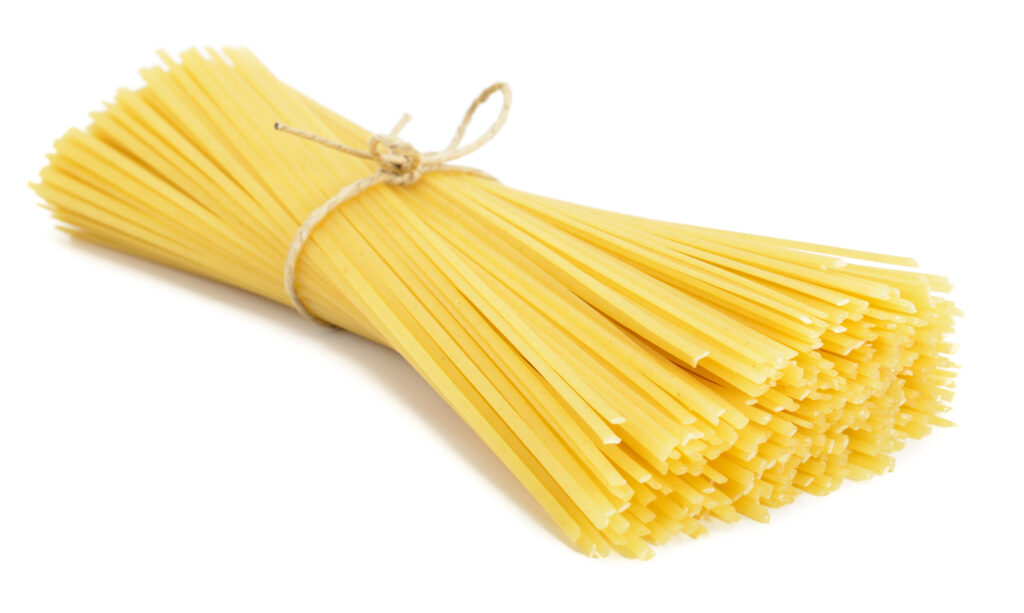Originating from Rome (arguably), carbonara is an iconic pasta dish celebrated for its straightforward yet flavorful composition. While variations exist, the most authentic carbonara recipe typically uses eggs, Pecorino Romano cheese, guanciale (cured pork cheek), and a generous dash of black pepper. A combination that’s meant to yield a creamy and delicious Italian classic. Want to make a lasting impression on your loved ones with a delicious homemade meal? How about trying this simple carbonara recipe that will surely delight their taste buds and make you a kitchen hero?
Ingredients (serves two)
. 120g Linguine pasta
. 60g Guanciale
. 4 Eggs
. 30-40g grated Pecorino Romano cheese
. 30-40g grated Parmigiano
. Black pepper
. Salt
Preparation
The Guanciale
Begin by sautéing the guanciale until it achieves a golden, crispy texture. This process enhances the dish with a rich flavour. Once the guanciale attains its desired crispiness, set it aside but still keeping it warm.
The Linguine
Fill a large pot with water, leaving some space at the top, and bring it to a boil on a stove. Once the water is boiling, optionally add some salt before adding the linguine. Boil until it reaches an al dente consistency, usually around 8-10 minutes, or until cooked to your liking.
Egg-Cheese Mixture
While the linguine is boiling, break the eggs into a large enough bowl and extract just the yolks. Next, add the grated Pecorino Romano, Parmigiano and black pepper into the bowl then simultaneously whisk to combine them seamlessly to create a creamy mixture.
Set this aside for use when the pasta is cooked.

Combining All the Ingredients
- When the pasta is ready, remove from the heat and drain the linguine.
- Immediately add in the egg-cheese mixture. Stir consistently while combining it with the pasta. This prevents localized heating and maintains a creamy, velvety texture without scrambling the eggs. This will also ensure the eggs evenly coat the pasta.
- Next, plate the pasta using a large serving spoon and fork to create a twirl.
- Now add a generous amount of crispy guanciale on top of the beautifully plated pasta mix.
- At this stage, you can additionally season the carbonara with freshly ground black pepper or more grated cheese.
- Serve immediately

Origins of Carbonara
Carbonara is a dish that’s often linked to the region of Lazio and in particular the city of Rome. Despite this, its origin remains a subject of debate, sparking theories about resourceful charcoal workers or American influences. Some have in fact attributed the first carbonara recipe to the post-WWII ingenuity of Roman charcoal workers, known as “carbonari,” who concocted a simple yet flavourful dish using readily available ingredients like eggs, Pecorino Romano cheese, guanciale, and black pepper.
Another theory suggests a possible connection to American influences, arguing that carbonara as we know it evolved from an adaptation of pasta with bacon and eggs introduced by Allied troops during the liberation of Italy.
Regardless of its contested beginnings, carbonara has become a global culinary sensation, celebrated for its uncomplicated yet delectable combination of flavours. The dish’s versatility and widespread appeal highlight its status as a timeless classic, transcending geographical boundaries and culinary traditions. Whether rooted in the resourcefulness of Roman workers or influenced by international dynamics, carbonara remains a symbol of culinary creativity and universal enjoyment.
What type of pasta is best for carbonara?

The ideal pasta for carbonara is traditionally spaghetti. And that is because its long, slender form not only ensures an even coating of the creamy sauce, allowing each strand to be perfectly enveloped but also serves as an ideal canvas for the harmonious blend of flavours. The porous surface of spaghetti guarantees an even coating of the creamy sauce.
While other pasta shapes, such as rigatoni or linguine, may find their way into variations of the dish, the classic pairing of carbonara with spaghetti remains a beloved favourite. This combination encapsulates the very essence of the iconic Roman dish, whether adhering to tradition or reflecting personal taste. The choice of spaghetti underscores the timeless appeal of carbonara, where simplicity seamlessly meets culinary excellence.
Ultimately, whether you stick to tradition or opt for a different pasta shape, it may just boil down to personal taste or the type of pasta you have readily available in your kitchen cupboard.
Do’s and Don’ts for Creating a Perfect Carbonara
- Wait for the Boil: Before adding the pasta, ensure the water is boiling. Starting with boiling water allows the pasta to cook evenly and maintain the desired texture, contributing to the overall perfection of your Carbonara.
- Preserve the Integrity of Long Pasta: Breaking long pasta might seem convenient, but it changes the dish’s texture. The length allows for a more satisfying twirl, ensuring the sauce coats each strand evenly.
- Salt the Water: Adding salt to boiling water does more than season the pasta. It enhances its natural taste, making every bite more enjoyable. It’s a small step that significantly impacts the overall dish.
- Serve Immediately: I am sure you already know that any pasta dish is at its best right after cooking. Allowing it to sit can lead to a change in texture and temperature, affecting the overall experience. You also don’t want your pasta all clumped up.
- Do not Use Cream or Butter: Traditional carbonara is a simple yet flavourful dish. Cream or butter alters the intended balance of flavours. Staying true to the classic recipe ensures a genuine and rich taste.
- Choose Guanciale over Bacon: Guanciale cured pork cheek, brings a unique flavour to carbonara. Its distinct taste complements the dish perfectly, providing a more authentic and satisfying culinary experience compared to bacon. Pancetta is also a good substitute
- Continuous Stirring: Stirring the egg mixture consistently while it’s in the pot with the pasta ensures a creamy and smooth texture. This step prevents the eggs from scrambling and guarantees a luscious, velvety sauce.
- Immediate Freshness: Carbonara is meant to be enjoyed immediately after serving. This ensures the pasta retains its ideal texture, and that the flavours are at their peak. Don’t wait – dive in for a fresh and delightful experience!
Give this easy and tasty carbonara recipe a try at home, and share your thoughts with me!
Buon Appetito!



